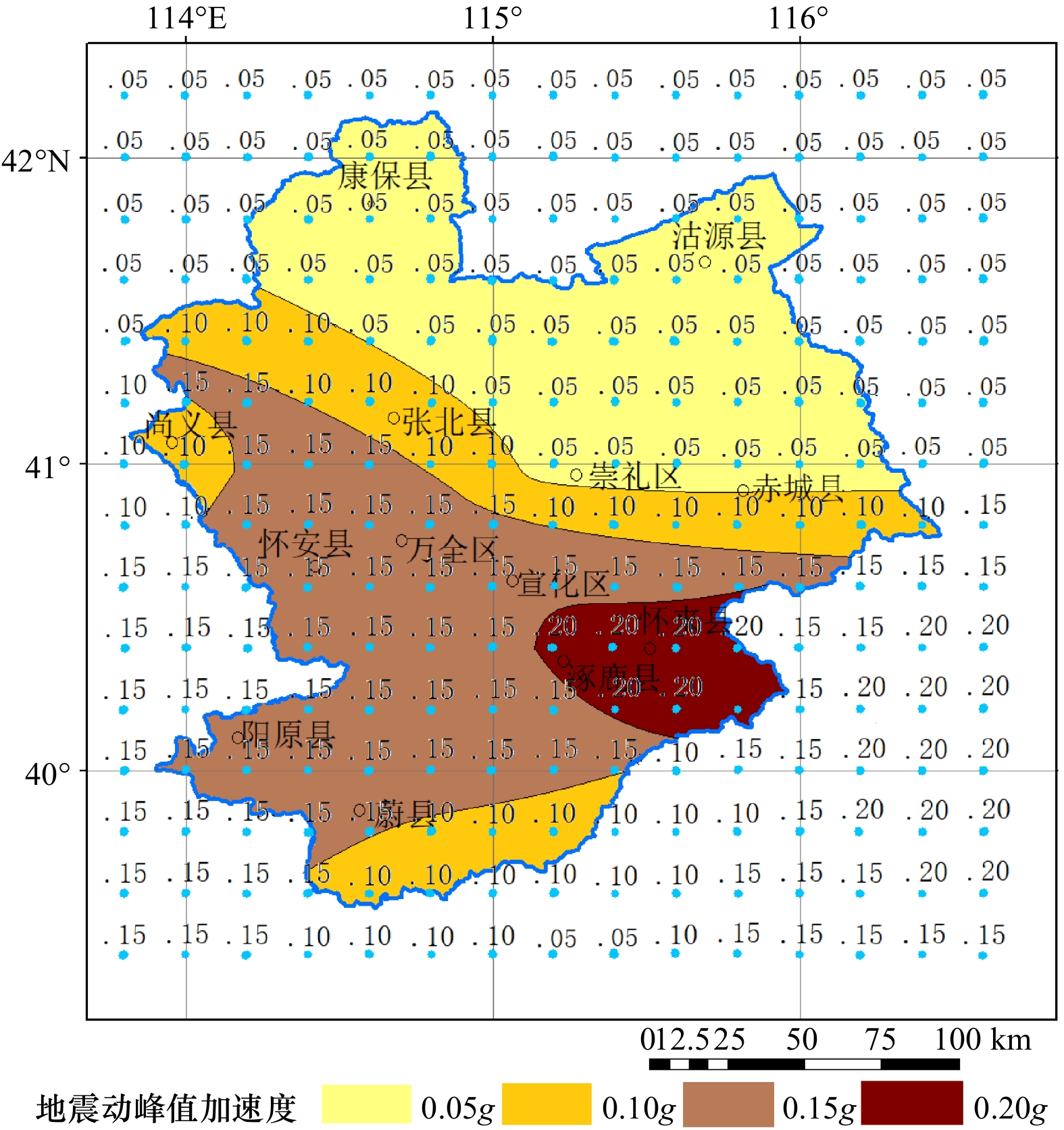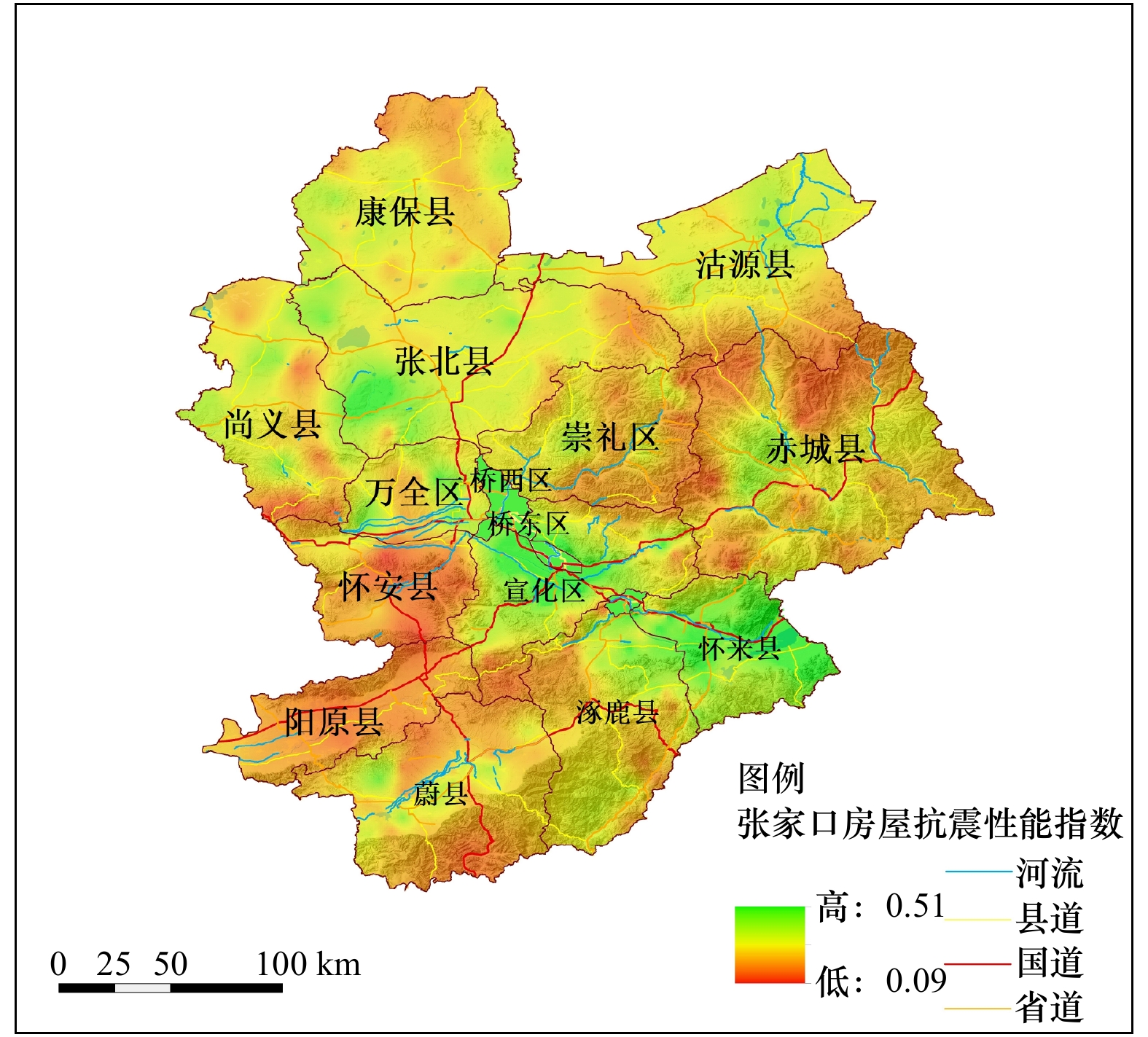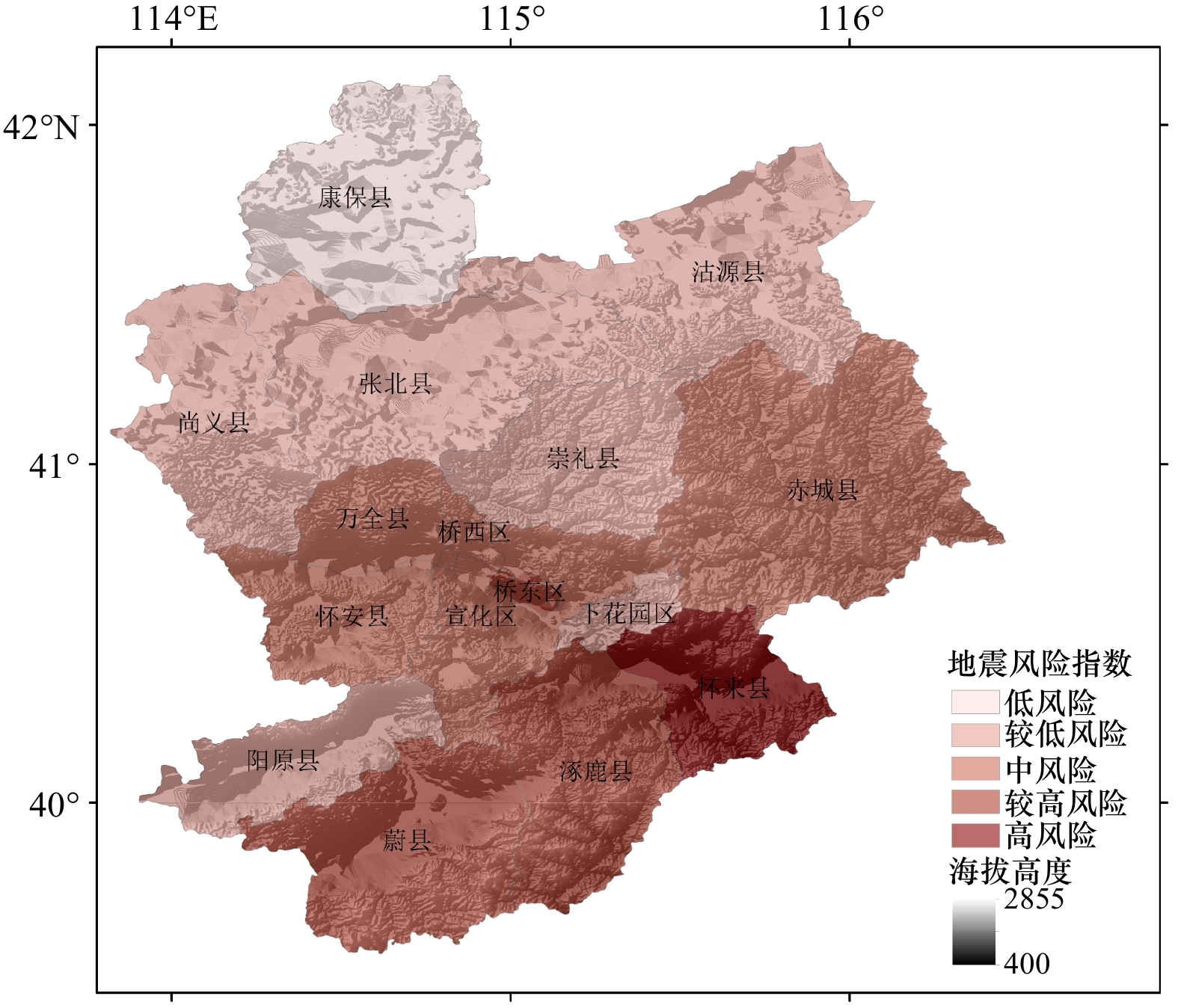Refined Risk Assessment of Earthquake Disaster in Zhangjiakou Area
-
摘要:
本文从地震灾害、建筑物、人口、经济、抗震救灾等多方面出发,将自然属性与社会属性进行有效结合,对地震危险性、建筑物抗震性能等影响因素进行详细分析,构建城镇地震灾害风险评价指标体系,以张家口地区16个县区为例,采用专家-层次分析法,建立精细化地震灾害风险评估模型。研究结果表明,城镇建筑物抗震性能普遍较差,怀来县地震灾害风险最大,桥东区、蔚县、涿鹿县、桥西区次之,沽源县、康保县地震灾害风险最小,并对各县区地震灾害风险主要影响因素进行讨论,发现地震风险指数与地形结构、建筑物抗震性能具有相关性,评估结果可为城镇制定防震减灾规划提供依据。
Abstract:In this paper, from the aspects of earthquake disaster, buildings, population, economy, earthquake relief and other aspects, the natural attributes and social attributes are effectively combined. From the aspects of seismic risk and seismic performance of buildings, the influencing factors of seismic risk and seismic performance of buildings are analyzed in detail, and the urban seismic disaster risk evaluation index system is constructed. For example, the expert analytic hierarchy process (AHP) is used to establish a refined earthquake disaster risk assessment model. The results show that there is a general deviation in seismic performance of urban buildings. Huailai County has the largest earthquake disaster risk, Qiaodong District, Yuxian County, Zhuolu county and Qiaoxi District take the second place, Guyuan County and Kangbao County have the lowest earthquake disaster risk. The main factors influencing the risk of each county are discussed. The results show that the seismic risk index has correlation with the results of terrain structure and seismic performance of buildings, which reflects the applicability of the evaluation results from the side, which can provide the basis for making earthquake prevention and disaster reduction planning in cities and towns.
-
Key words:
- Earthquake disaster risk /
- Index system /
- Seismic risk /
- Seismic performance
-
表 1 张家口地区地震灾害风险评估指标体系解释
Table 1. Interpretation of index system of earthquake disaster risk assessment in Zhangjiakou area
指标 含义 地震强度 主要包括地震动参数和断层指标 地震频度 统计张家口地区1970年以来4级以上地震发生的次数 爆炸、毒气放射源 主要考查各类化工厂、化肥厂和农药厂发生泄漏与爆炸的危险性 次生火灾 主要考查工业易燃物指标和重点防火区密度等因素 次生水灾 主要考查评价地区水库和河流数等因素 滑坡 主要考查穿越山谷公路里程数以及岩层坚实程度等因素 泥石流 主要考查地质构造和降雨等因素 人口密度 单位面积土地上居住的人口数 人口增长率 一年内新增人口占原有人口的比例 人口流动性 主要考查每日城镇居民通勤流动活跃度 每平方公里建筑物面积 主要考查建筑物面积占该地区实际面积比例 建筑物增长率 统计近5年建筑物年均增长率 老年人抚养比 统计非劳动年龄人口数中老年人部分占劳动年龄人数之比 少年儿童抚养比 统计少年儿童人数占劳动年龄人数之比 建筑物抗震性能情况 主要考查建筑物在面对地震灾害时的承受能力 GDP增长情况 统计近5年人均GDP增长率 失业率 统计失业人口占劳动人口的比例 人均收入 主要反映个人防灾能力的指标 医生比例 从医疗能力方面进行考查的指标 病床数 从医疗能力方面进行考查的指标 救援力量 从该地区物资储备、救援队伍规模等方面进行衡量 避难场所 依据人均绿地面积即城镇公共绿地面积与城镇非农业人口之比进行考查 每平方公里道路面积 现有公路面积与该地区总面积之比 每平方公里河流桥梁数 现有河流桥梁数与该地区河流总面积之比 表 2 判断矩阵标度及其含义
Table 2. The scale of judgment matrix and its meaning
序号 重要性等级 Cxy赋值 序号 重要性等级 Cxy赋值 1 元素x,y同等重要 1 6 元素x较元素y稍不重要 1/3 2 元素x较元素y稍重要 3 7 元素x较元素y明显不重要 1/5 3 元素x较元素y明显重要 5 8 元素x较元素y强烈不重要 1/7 4 元素x较元素y强烈重要 7 9 元素x较元素y极端不重要 1/9 5 元素x较元素y极端重要 9 表 3 城镇地震灾害风险评价指标权重
Table 3. Index weight of urban earthquake disaster risk assessment
因子层 副因子层 指标层 权重 危险性(h)0.4957 直接危险性0.7656 地震强度0.8 0.3036 地震频度0.2 0.0759 次生危险性0.2344 爆炸、毒气放射源0.0636 0.0074 次生火灾0.3118 0.0366 次生水灾0.0652 0.0076 滑坡0.3434 0.0399 泥石流0.2161 0.0251 暴露性(e)0.2001 人口0.7916 人口密度0.6737 0.1067 人口增长率0.1889 0.0299 人口流动性0.1374 0.0218 建筑物0.208 每平方公里建筑物面积0.764 0.0318 建筑物增长率0.2358 0.0098 脆弱性(v)0.1245 人口0.2275 老年人抚养比0.202 0.0057 少年儿童抚养比0.797 0.0227 建筑物0.4143 建筑物抗震性能情况1 0.0516 经济情况0.3582 GDP增长情况0.766 0.0342 失业率0.234 0.0104 抗震救灾能力(c)0.1797 自救资源0.766 人均收入0.443 0.0610 医生比例0.4154 0.0572 病床数0.1403 0.0193 流通性0.234 救援力量0.4582 0.0193 避难场所0.3108 0.0131 每平方公里道路面积0.1363 0.0057 每平方公里河流桥梁数0.0948 0.0040 表 4 张家口地区地震动参数(地震强度)
Table 4. Parameter table of ground motion parameters (earthquake intensity) in Zhangjiakou area
编号 区/县 $ {{\rm{\alpha }}_{{\rm{maxII}}}}$ 编号 区/县 $ {{\rm{\alpha }}_{{\rm{maxII}}}}$ 1 桥东区 0.155 9 蔚县 0.156 2 桥西区 0.152 10 阳原县 0.173 3 宣化区 0.156 11 怀安县 0.155 4 下花园区 0.199 12 万全区 0.162 5 张北县 0.130 13 怀来县 0.216 6 康保县 0.072 14 涿鹿县 0.22 7 沽源县 0.053 15 赤城县 0.107 8 尚义县 0.124 16 崇礼区 0.104 表 5 张家口地区房屋建筑结构抗震性能参数表
Table 5. Table of seismic performance parameters of building structures in Zhangjiakou area
序号 房屋类型 代表符号 参数 1 砖混结构 JG1 0.8 2 砖木结构 JG2 0.5 3 土木结构 JG3 0.2 4 土坯结构 JG4 0.1 表 6 张家口地区房屋场地条件性能参数表
Table 6. Table of performance parameters of house site conditions in Zhangjiakou area
序号 分类 代表符号 参数 1 有利地段 Cd1 1.0 2 一般地段 Cd2 0.9 3 不利地段 Cd3 0.7 4 危险地段 Cd4 0.5 表 7 张家口地区房屋抗震措施抗震性能参数表
Table 7. Table of seismic performance parameters of buildings in Zhangjiakou area
序号 分类 代表符号 参数 1 有措施 CS1 1.0 2 无措施 CS2 0.7 表 8 张家口地区房屋抗震性能指数
Table 8. Seismic performance index of buildings in Zhangjiakou area
序号 区县 P 序号 区/县 P 1 桥东区 0.500 9 蔚县 0.217 2 桥西区 0.500 10 阳原县 0.198 3 宣化区 0.354 11 怀安县 0.149 4 下花园区 0.470 12 万全区 0.303 5 张北县 0.293 13 怀来县 0.446 6 康保县 0.235 14 涿鹿县 0.305 7 沽源县 0.221 15 赤城县 0.273 8 尚义县 0.252 16 崇礼区 0.238 表 9 张家口地区地震灾害风险评估指标量化值
Table 9. Normalized value of earthquake disaster risk assessment index in Zhangjiakou area
指标 区县 桥东区 桥西区 宣化区 下花园区 张北县 康保县 沽源县 尚义县 蔚县 阳原县 怀安县 万全区 怀来县 涿鹿县 赤城县 崇礼区 地震强度 0.70 0.69 0.71 0.90 0.59 0.33 0.24 0.56 0.71 0.79 0.70 0.74 0.98 1.00 0.49 0.47 地震频度 0.00 0.00 0.12 0.03 1.00 0.00 0.00 0.06 0.06 0.03 0.03 0.06 0.12 0.03 0.03 0.00 爆炸、毒气放射源 0.45 1.00 0.52 0.25 0.09 0.09 0.10 0.09 0.20 0.24 0.17 0.34 0.31 0.17 0.05 0.15 次生火灾 0.97 0.86 0.88 1.00 0.81 0.32 0.27 0.38 0.54 0.56 0.75 0.86 0.81 0.91 0.95 0.43 次生水灾 0.71 0.89 0.76 0.53 0.95 0.32 0.84 1.00 0.86 0.63 0.75 0.81 1.03 0.21 0.53 0.37 滑坡 0.29 0.06 0.47 0.12 0.16 0.14 0.31 0.20 0.53 0.31 0.41 0.43 0.33 0.57 1.00 0.82 泥石流 0.40 0.20 0.80 0.16 0.22 0.20 0.44 0.24 0.88 0.42 0.60 0.64 0.30 0.76 1.00 0.86 人口密度 1.00 0.71 0.54 0.10 0.15 0.06 0.03 0.08 0.60 0.18 0.17 0.24 0.69 0.34 0.06 0.21 人口增长率 0.85 0.56 0.55 0.30 0.36 −0.24 0.76 0.17 1.00 0.26 0.67 0.31 0.45 −0.01 0.92 0.16 人口流动性 0.90 1.00 0.86 0.34 0.57 0.25 0.28 0.39 0.39 −0.16 0.20 0.32 0.26 0.15 0.27 0.38 每平方公里建筑物面积 0.24 0.15 0.18 0.02 0.16 0.04 0.03 0.04 1.00 0.17 0.10 0.18 0.77 0.39 0.08 0.03 建筑物增长率 0.45 1.00 0.73 0.33 0.57 0.15 0.12 0.00 0.01 0.15 0.04 0.30 0.27 0.31 0.61 0.65 老年抚养比 0.72 0.73 0.79 0.96 0.87 0.88 0.77 0.93 0.86 0.91 0.98 0.92 0.74 0.80 1.00 0.93 少年儿童
抚养比0.49 0.53 0.66 0.52 0.74 0.69 0.68 0.74 1.00 0.92 0.77 0.81 0.70 0.71 0.84 0.69 建筑物抗震性能情况 1.00 0.90 0.56 0.60 0.35 0.30 0.32 0.34 0.27 0.26 0.27 0.38 0.56 0.41 0.24 0.31 GDP增长情况 0.22 0.68 −0.22 0.17 0.83 0.64 1.00 0.62 −0.01 −0.12 0.45 0.82 0.49 0.72 0.62 0.24 失业率 0.91 0.96 0.68 0.73 0.89 0.91 0.56 0.80 0.62 0.73 0.84 0.93 1.00 0.68 0.89 0.70 人均收入 1.00 0.92 0.73 0.73 0.50 0.44 0.45 0.40 0.50 0.41 0.48 0.55 0.67 0.58 0.50 0.53 医生比例 0.40 1.00 0.35 0.28 0.18 0.18 0.16 0.20 0.19 0.23 0.22 0.24 0.20 0.22 0.18 0.27 病床数 0.55 1.00 0.48 0.09 0.43 0.17 0.16 0.18 0.33 0.19 0.18 0.26 0.36 0.32 0.23 0.10 救援力量 1.00 1.00 0.60 0.60 0.16 0.16 0.16 0.20 0.20 0.16 0.16 0.16 0.80 0.20 0.40 0.24 避难场所 1.00 0.18 0.05 0.00 0.10 0.03 0.03 0.00 0.62 0.10 0.04 0.00 0.17 0.10 0.01 0.05 每平方公里道路面积 0.57 0.30 0.24 0.04 0.40 0.06 0.05 0.07 1.00 0.17 0.13 0.35 0.65 0.24 0.07 0.04 每平方公里河流桥梁数 0.45 0.79 0.95 0.82 0.15 0.03 0.06 0.13 0.29 0.76 0.66 1.00 0.84 0.42 0.24 0.40 表 10 张家口地区城镇地震灾害风险指数
Table 10. Urban earthquake disaster risk index in Zhangjiakou
序号 区/县 IEDRI 序号 区/县 IEDRI 1 桥东区 0.029 9 蔚县 0.027 2 桥西区 0.02 10 阳原县 0.008 3 宣化区 0.016 11 怀安县 0.015 4 下花园区 0.008 12 万全区 0.019 5 张北县 0.011 13 怀来县 0.038 6 康保县 0.002 14 涿鹿县 0.024 7 沽源县 0.007 15 赤城县 0.015 8 尚义县 0.008 16 崇礼区 0.008 表 11 张家口地区16个区县影响因素量化值
Table 11. Quantitative value of influencing factors in 16 counties of Zhangjiakou
序号 区/县 Dh De Dv Dc IEDRI 序号 区/县 Dh De Dv Dc IEDRI 1 桥东区 0.74 1.00 0.87 0.83 0.76 9 蔚县 0.74 0.82 0.50 0.42 0.71 2 桥西区 0.69 0.79 1.00 1.00 0.53 10 阳原县 0.75 0.19 0.45 0.32 0.20 3 宣化区 0.76 0.65 0.50 0.57 0.42 11 怀安县 0.73 0.28 0.64 0.33 0.39 4 下花园区 0.85 0.19 0.65 0.49 0.21 12 万全区 0.77 0.31 0.85 0.39 0.51 5 张北县 0.40 0.31 0.81 0.35 0.28 13 怀来县 0.92 0.73 0.80 0.53 1.00 6 康保县 0.33 0.05 0.71 0.28 0.04 14 涿鹿县 1.00 0.33 0.77 0.39 0.64 7 沽源县 0.30 0.21 0.79 0.27 0.18 15 赤城县 0.66 0.29 0.70 0.34 0.39 8 尚义县 0.53 0.15 0.72 0.28 0.20 16 崇礼区 0.57 0.26 0.55 0.36 0.22 -
丁香, 王晓青, 王龙等, 2011. 地震巨灾风险评估系统的研制与应用. 震灾防御技术, 6(4): 454—460.Ding X., Wang X. Q., Wang L., et al., 2011. The development and application of catastrophe earthquake risk estimation system. Technology for Earthquake Disaster Prevention, 6(4): 454—460. (in Chinese) 杜栋, 庞庆华, 吴彦, 2008. 现代综合评价方法与案例精选. 2版. 北京: 清华大学出版社.Du D., Pang Q. H., Wu Y., 2008. Modern comprehensive evaluation method and case selection. 2nd ed. Beijing: Tsinghua University Press. (in Chinese) 侯林锋, 李大卫, 周新民, 2019. 基于指标体系的浙江省地震灾害风险评估. 华北地震科学, 37(4): 23—28.Hou L. F., Li D. W., Zhou X. M., 2019. Earthquake risk assessment in Zhejiang Province based on index system. North China Earthquake Sciences, 37(4): 23—28. (in Chinese) 李昌珑, 李宗超, 吕红山等, 2019. 基于三维图像模式识别的西藏东南部地震灾害损失风险评估. 地球物理学报, 62(1): 393—410.Li C. L., Li Z. C., Lv H. S., et al., 2019. Seismic disaster loss risk assessment for southeastern Tibet based on 3D image pattern recognition. Chinese Journal of Geophysics, 62(1): 393—410. (in Chinese) 李皓, 刘金龙, 江小林等, 2018. 2017年九寨沟7.0级地震灾害特点浅析. 震灾防御技术, 13(3): 679—688.Li H., Liu J. L., Jiang X. L., et al., 2018. Characteristic hazard analysis of the Jiuzhaigou MS 7.0 earthquake in 2017. Technology for Earthquake Disaster Prevention, 13(3): 679—688. (in Chinese) 李津津, 张合, 温超, 2017. 河北省地震动参数区划图变化. 地震地磁观测与研究, 38(3): 185—190.Li J. J., Zhang H., Wen C., 2017. Partial changes of the seismic ground motion parameters zoning map of China in Hebei province. Seismological and Geomagnetic Observation and Research, 38(3): 185—190. (in Chinese) 刘龙, 刘志辉, 刘晓丹等, 2019. 张北地区农村房屋抗震性能分析. 华北地震科学, 37(2): 82—88.Liu L., Liu Z. H., Liu X. D., et al., 2019. Analysis of the seismic performance of rural houses in the areas of Zhangbei. North China Earthquake Sciences, 37(2): 82—88. (in Chinese) 刘晓丹, 刘志辉, 刘龙等, 2019. 张家口地区农村房屋建筑特征和抗震能力评价. 地震研究, 42(2): 158—165.Liu X. D., Liu Z. H., Liu L., et al., 2019. Features and seismic capacity evaluation of rural houses in Zhangjiakou Area. Journal of Seismological Research, 42(2): 158—165. (in Chinese) 吕大刚, 于晓辉, 2013. 基于地震易损性解析函数的概率地震风险理论研究. 建筑结构学报, 34(10): 41—48.Lv D. G., Yu X. H., 2013. Theoretical study of probabilistic seismic risk assessment based on analytical functions of seismic fragility. Journal of Building Structures, 34(10): 41—48. (in Chinese) 吕国军, 张合, 孙丽娜, 2016. 张家口地区农村房屋抗震性能调查分析研究. 地震工程学报, 38(S2): 302—307.Lv G. J., Zhang H., Sun L. N., 2016. Investigation and analysis of the earthquake resistance capability of rural houses in the Zhangjiakou Area. China Earthquake Engineering Journal, 38(S2): 302—307. (in Chinese) 茅远哲, 曹筠, 高晨等, 2019. 京西北地区地应变观测与小震震源机制解一致性研究. 中国地震, 35(4): 709-717.Mao Y. Z., Cao J., Gao C., et al., 2019. Consistency of ground strain observation and source mechanism solution of small earthquakes in northwest Beijing. Earthquake Research in China, 35(4): 709—717. (in Chinese) 明小娜, 陈勤, 周洋等, 2018. 云南地方政府地震应急准备能力评价指标与计算. 地震研究, 41(1): 132—138.Ming X. N., Chen Q., Zhou Y., et al., 2018. Evaluation index for earthquake preparedness capability of Yunnan local government and its calculation method. Journal of Seismological Research, 41(1): 132—138. (in Chinese) 聂高众, 高建国, 马宗晋等, 2002. 中国未来10~15年地震灾害的风险评估. 自然灾害学报, 11(1): 68—73. doi: 10.3969/j.issn.1004-4574.2002.01.011Nie G. Z., Gao J. G., Ma Z. J., et al., 2002. On the risk of earthquake disaster in China in the coming 10~15 years. Journal of Natural Disasters, 11(1): 68—73. (in Chinese) doi: 10.3969/j.issn.1004-4574.2002.01.011 唐丽华, 李山有, 宋立军, 2016. 地震灾害风险评估方法的对比分析——以乌鲁木齐市为例. 地震工程学报, 38(5): 838—845.Tang L. H., Li S. Y., Song L. J., 2016. Comparative analysis of earthquake risk assessment methods: a case study on Urumqi City. China Earthquake Engineering Journal, 38(5): 838—845. (in Chinese) 肖凯灵, 2011. 城市地震灾害风险的损失评价研究. 西安: 西安石油大学.Xiao K. L., 2011. Study of loss assessment of urban earthquake disaster risk. Xi’an: Xi’an Shiyou University. (in Chinese) 张春山, 张业成, 张立海, 2004. 中国崩塌、滑坡、泥石流灾害危险性评价. 地质力学学报, 10(1): 27—32.Zhang C. S., Zhang Y. C., Zhang L. H., 2004. Danger assessment of collapses, landslides and debris flows of geological hazards in China. Journal of Geomechanics, 10(1): 27—32. (in Chinese) 张家口市人民政府, 2019. 张家口年鉴. 北京: 九州出版社.Zhangjiakou Municipal People's government, 2019. Zhangjiakou Yearbook. Beijing: Jiuzhou publishing house.(in Chinese) 赵思健, 2012. 自然灾害风险分析的时空尺度初探. 灾害学, 27(2): 1—6, 18.Zhao S. J., 2012. A preliminary study on the spatial and temporal scales of natural disaster risk analysis. Journal of Catastrophology, 27(2): 1—6, 18. (in Chinese) 赵真, 郭红梅, 张莹, 2020. 面向市县层级的地震灾害风险评估系统设计与实现. 震灾防御技术, 15(2): 419—430.Zhao Z., Guo H. M., Zhang Y., 2020. Design and implementation of earthquake disaster risk assessment system for county. Technology for Earthquake Disaster Prevention, 15(2): 419—430. (in Chinese) 中华人民共和国国家质量监督检验检疫总局, 中国国家标准化管理委员会, 2016. GB/T 18306—2015 中国地震动参数区划图. 北京: 中国标准出版社.General Administration of Quality Supervision, Inspection and Quarantine of the People’s Republic of China, National Standardization Administration of China, 2016. GB/T 18306—2015 Seismic ground motion parameters zonation map of China. Beijing: Standards Press of China. (in Chinese) 中华人民共和国住房和城乡建设部, 中华人民共和国国家质量监督检验检疫总局, 2010. GB/T 50011—2010 建筑抗震设计规范. 北京: 中国建筑工业出版社.Ministry of Housing and Urban-Rural Development of the People’s Republic of China, General Administration of Quality Supervision, Inspection and Quarantine of the People's Republic of China. 2010. GB/T 50011—2010 Code for seismic design of buildings. Beijing: China Architecture & Building Press. (in Chinese) 周寅康, 1995. 自然灾害风险评价初步研究. 自然灾害学报, 4(1): 6—11.Zhou Y. K., 1995. Study on natural disaster risk assessment. Journal of Natural Disasters, 4(1): 6—11. (in Chinese) Schneider P. J., Schauer B. A., 2006. HAZUS-its development and its future. Natural Hazards Review, 7(2): 40—44. Silva V., Crowley H., Pagani M., et al., 2014. Development of the OpenQuake engine, the Global Earthquake Model’s open-source software for seismic risk assessment. Natural Hazards, 72(3): 1409—1427. -




 下载:
下载:






